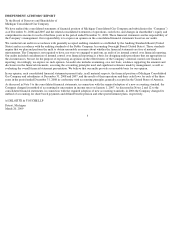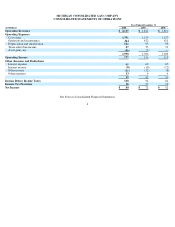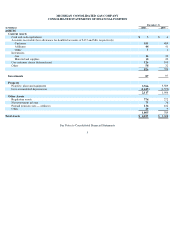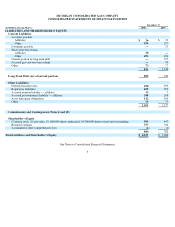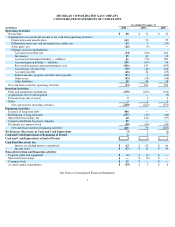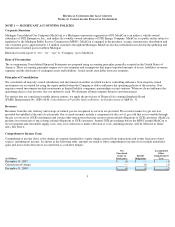DTE Energy 2008 Annual Report Download - page 14
Download and view the complete annual report
Please find page 14 of the 2008 DTE Energy annual report below. You can navigate through the pages in the report by either clicking on the pages listed below, or by using the keyword search tool below to find specific information within the annual report.
Investments in Debt and Equity Securities
The Company generally classifies investments in debt and equity securities as trading and has recorded such investments at market value with
unrealized gains or losses included in earnings.
Asset Gains, net
In 2008 and 2007, we sold base gas resulting in gains of $22 million and $5 million, respectively. Proceeds from the 2008 and 2007 base gas
sales were received in January 2009 and January 2008, respectively. Also in 2008 and 2007, we sold land for gains of $2 million and
$1 million, respectively. The 2007 gain was partially offset by $3 million for the disallowance of certain costs related to the acquisition of
pipeline assets. In 2006, we sold certain investment rights related to storage field construction for a $3 million pre-tax gain. This gain was
offset by a $3 million loss as a result of a reduction to MichCon’s 2004 GCR underrecovery related to the accounting treatment of the injected
base gas remaining in the New Haven storage field when it was sold in early 2004.
See the following notes for other accounting policies impacting our financial statements:
NOTE 2 — NEW ACCOUNTING PRONOUNCEMENTS
Fair Value Accounting
In September 2006, the FASB issued SFAS No. 157, Fair Value Measurements. SFAS No. 157 defines fair value, establishes a framework for
measuring fair value in generally accepted accounting principles, and expands disclosures about fair value measurements. It emphasizes that
fair value is a market-based measurement, not an entity-specific measurement. Fair value measurement should be determined based on the
assumptions that market participants would use in pricing an asset or liability. Effective January 1, 2008, the Company adopted SFAS No. 157.
As permitted by FASB Staff Position FAS No. 157-2, the Company has elected to defer the effective date of SFAS No. 157 as it pertains to
non-financial assets and liabilities to January 1, 2009. See also Note 9.
In February 2007, the FASB issued SFAS No. 159, The Fair Value Option for Financial Assets and Financial Liabilities — Including an
A
mendment of FASB Statement No. 115. This Statement permits an entity to choose to measure many financial instruments and certain other
items at fair value. The fair value option established by SFAS No. 159 permits all entities to choose to measure eligible items at fair value at
specified election dates. An entity will report in earnings unrealized gains and losses on items, for which the fair value option has been elected,
at each subsequent reporting date. The fair value option: (a) may be applied instrument by instrument, with a few exceptions, such as
investments otherwise accounted for by the equity method; (b) is irrevocable (unless a new election date occurs); and (c) is applied only to
entire instruments and not to portions of instruments. SFAS No. 159 is effective as of the beginning of an entity’s first fiscal year that begins
after November 15, 2007. At January 1, 2008, the Company elected not to use the fair value option for financial assets and liabilities held at
that date.
In October 2008, the FASB issued FASB Staff Position (FSP) 157-3, Determining the Fair Value of a Financial Asset in a Market That is Not
A
ctive. The FSP clarifies the application of SFAS No. 157, Fair Value Measurements, in an inactive market, and provides an illustrative
example to demonstrate how the fair value of a financial asset is determined when the market for that financial asset is inactive. The FSP was
effective upon issuance, including prior periods for which financial statements have not been issued. The adoption of the FSP did not have a
material impact on the Company’s consolidated financial statements.
12
Note Title
2 New Accounting Pronouncements
4 Regulatory Matters
5 Income Taxes
10 Financial and Other Derivative Instruments
12 Retirement Benefits and Trusteed Assets



